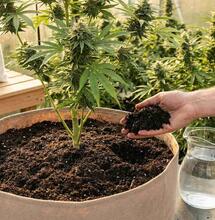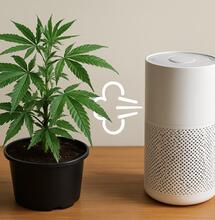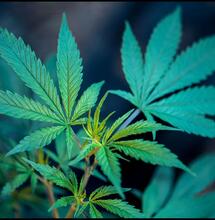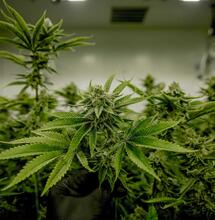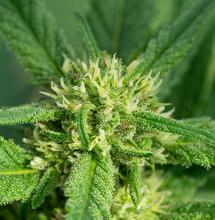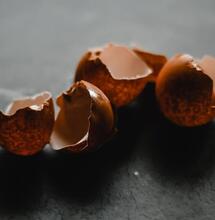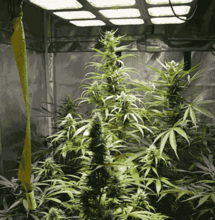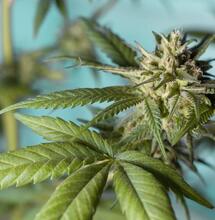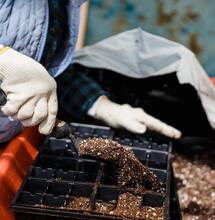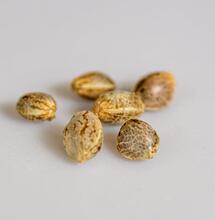How to Manage Over-stretching Cannabis Plants?
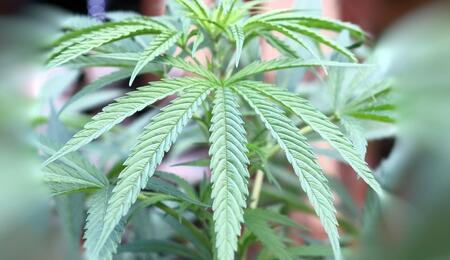
Stretching marijuana plants can be a nightmare, but it is both preventable and, if the situation arises, treatable. In this article, learn about different techniques that you can use in managing (or completely avoiding) over-stretching cannabis plants in your grow room.
Growing indoors has plenty of benefits. It is good fun to play god, giving life to your plants and controlling the amount of light, food and water they receive. You can cultivate strains that would otherwise have no chance to flourish in certain climates. Plus, it is nice to have a hobby that does not involve trawling the web for porn! But it is not without its setbacks: heat, noise, smells, electricity bills and - one of the big ones - space. There is no sicker feeling than switching your crop into flower and watching it stretch and stretch... and stretch, devouring the vertical space in your grow room. It is a natural and relatively unavoidable issue, but there are a few things that can be done to combat the dreaded stretch.
How to Prevent Excessive Stretching?
First off, you will want to make sure that your plants are dense and bushy to begin with. This involves two things: keeping the internodal distance short and promoting lateral growth.
Internode distance may sound complicated, but put simply it means the distance between the stems (nodes) on the plant - specifically, the distance between the internodes of leaf stems on the main stem of the plant. The greater the internode distance on the plant, the more spindly the plant will look.
Long, spindly plants are a bad thing, as they will be underdeveloped and less likely to be able to physically support your desired amount of bud sites. They will often need more plant supports than normal and you run the risk of losing buds through snapped stems - a truly devastating experience!
Obviously, a stretched plant will seriously impact the amount of headroom that you have under grow lights, which can cause you issues with light burn at the top of your plants, another yield reducer; also, the lower branches will receive less light intensity, because you will have to raise your lights high up and they will develop less bud as a result. It is pretty much bad news all around.
As we all know, prevention is better than than cure, but for those of you who are suffering from stretchy plants - and there may be several of you, especially if you were recently working with fewer lights - take a look at this guide on training cannabis plants. Using techniques such as pruning and super-cropping could be useful, and you may be able to pull things back around and get a decent yield.
Pruning plants in veg and early flower will affect the flow of auxins within the plant. Auxins are the hormones that play a major part in coordinating how the plant grows. Redistributing natural growth hormones from the main stem towards lateral stems is a good way to slow height growth and force the plant to bush out.
So, to prevent excessive stretching in the first place, we need to know what causes it. Disregarding genetic factors (some strains are just naturally stretchy), the two main causes are light and temperature. Surprise, surprise, the key to getting the best from your plants is a good environment! These tips are designed to be employed from day one of your grow, not just in the period that many growers out there refer to as 'the stretch', or when the plants are switched from eighteen hours of light down to twelve hours. There are some specific techniques for dealing with that stage and we shall get to that later.
Temperature is probably the best place to start. Even if your light levels are 100-percent optimized, you still run the risk of stretchy plants if your temperatures are not up to scratch. Try to maintain a grow room temperature of between seventy-three and eighty-two degrees Fahrenheit (twenty-three to twenty-eight degrees Celsius). If you have automated temperature control in the grow room that’s great. Alternatively, and a bit 'old school', you can also get a min/max hygro-thermometer. This will record the minimum and maximum temperature reached in your grow room; this is very important because a major factor in internode distance is the difference between the day and night temperatures. Put simply, the closer your day and night temperatures are to each other, the less your plants will stretch.
Using the DIF Technique for Cannabis Plant Stretching
Going a bit more technical, the technique of manipulating day and night temps to control plant growth is known in commercial horticulture as the DIF Technique - 'DIF' just stands for 'difference.' When the day temps are higher than the night temps, it is known as positive DIF. The more positive the DIF is, the greater the internode distance will be. When night temps are higher than the day temps, it is referred to as negative DIF. The more negative the DIF is, the shorter the internode distance will be.
Applying a negative DIF can actually be used to inhibit growth completely. A commercial farmer may do this to hold back certain crops, so that all crop varieties are ready to harvest at the same time. The DIF technique can be easily applied in the grow room by moderating your day and night temperatures. Maintaining a marginally positive DIF of a few degrees will keep your plants growing at the required rate, with nice, short internode spacing.
If, for whatever reason, you want to hold your plants back slightly (maybe you are waiting for space in the flowering room to become available) and decide to maintain a negative DIF - that is, keep the night temps higher than the day temps - be aware that humidity can really creep up when the lights are off in a grow room. You will also want to ensure that the room is adequately ventilated to prevent mold from settling in.
One technique that you could use is a cool morning pulse. This is where you drop the room temperature by a few degrees for the first two to three hours of lights on, and then allow it to increase into positive DIF after that. This is said to have an effect similar to maintaining negative DIF, but will reduce the risk of the humidity creeping up.
You can achieve the 'cool morning pulse' by using a temperature-controlled fan in a smaller room or an air conditioning unit in a larger room.
If you cannot get your head around the technical stuff and just want your plants to grow at a decent rate, you will do just fine if you simply remember not to let your night temps drop too far from your day temps.

How to Manage Lights for Controlling Cannabis Plant Stretch?
The next thing to look at is your lighting. Make sure that you have got enough light intensity for your space; otherwise, you will end up with plants that stretch out searching for light, with long internode spacing. As stated before, this means that you will have to raise your lights to cater for the taller plants and as a result will lose valuable headroom, which could have been filled with buds.
In an ideal world, or grow room, the plant will be at its optimum flowering potential when all of the bud sites are bathed in equally intense light. The plant is evenly lit and produces dense buds from top to bottom. A good example of this would be plants that are grown outdoors, with lots of space around them. This is because sunlight has the ability to penetrate deep into the canopy and all of the bud sites receive equal light intensity.
However, when using artificial lighting, the intensity of the light diminishes exponentially with distance - we will not go into the mathematics here, save that for another article on the inverse square law - but, suffice to say, it is shocking how much intensity a 600-watt bulb loses over a distance of just twelve inches (thirty centimeters). This is why, when growing indoors, fairly often you may experience small, airy, popcorn buds from the lower bud sites. The artificial light just cannot penetrate the canopy and develop those hard-to-reach areas.
You must ensure that the light intensity is kept as high as possible by lowering the bulb/LEDs as close to the top of your plants as you can without burning them. There are various types of reflectors available on the market that help to dissipate the heat generated by the grow light; parabolic umbrella-style reflectors and 'Adjust-a-Wings' are just two good ones of many. Air-cooled reflectors are also an option. Just make sure that you maintain the glass and aluminum on your reflectors; keep them as clean as possible throughout the full growth cycle. Dust will seriously reduce light intensity - dirty glass can reduce light levels by twenty percent!
Ultimately, there is no exact lamp height measurement to follow. This will all depend upon environmental factors, equipment used and also the strain chosen, as different strains are more tolerant of heat than others. However, as a rough guide for a 600-watt lamp for example, start at a distance of thirty-five to forty inches (ninety to one-hundred centimeters) from the bulb for a young plant and reduce the distance to around eighteen inches as the plants mature. Or, place the back of your hand level with the canopy; if the lamp burns your hand, it will also burn your plants!
Do not overcrowd your growing space. Plan your space before you start and remember not to fill your grow area with too many plants. Overcrowding can be a major factor in producing stretchy plants. As your plants grow, the leaves will quickly overlap their neighbors and light will not penetrate through. Eventually, the lower portions of the plant will experience significant shading. It is assumed that shading changes the actual light quality, resulting in the light below plant canopies being richer in near-infrared and far-red, which encourages plant stretching. Put simply, not only do the plants fight for the light and stretch towards it, but the light that they do receive in the shade actually encourages the stretching further.
How to Use Different Types of Lights and Lamps?
Intensity is not the only factor to consider when thinking about your lighting. Different types of lighting used at different stages of growth will also help to reduce stretch.
When considering your propagation setup, only put young seedlings or cuttings on a windowsill if there is no other option. If the window receives direct sunlight, the young plants may cook and wilt away. If the window does not receive direct light, the seedlings will stretch to try and find the light source.
These days automated LED lights can work efficient for different stages of growth. Otherwise, you can opt for T5 or PL propagation light. These cheap, low-wattage, high-output fluorescents can be placed directly onto a propagator. They give off the cool, white light that plants need for strong development.
For the vegetative stage, a blue compact fluorescent (CFL) or, even better, a metal halide (MH) bulb can also be used. These both produce light in the white-blue spectrum, which encourages vegetative growth and bushiness while discouraging vertical growth, keeping the internode distance short.
Finally, let us take a look at what we can do in order to minimize stretch when switching into flower, that is, by reducing the lights from eighteen to twelve hours. When switching the light cycle, you can expect a further two weeks of vigorous vertical growth - it is unavoidable. Since plants need nitrogen for vigorous growth, you might think that switching over to flowering feeds immediately would eliminate vertical growth; unfortunately, it does not. The plant requires nitrogen through the start of the flowering phase and reducing the availability of it will just bring on premature yellowing. This is why most nutrient manufacturers recommend feeding growth stage nutes until the third week of flower.
Continuing the use of metal halide lighting from the veg stage into the first two weeks of flower will help to keep the distance between internodes shorter. In fact, immediately switching to a sodium bulb in flowering can be a bad idea, as the infrared and far-red colors that promote bud growth later in the cycle also promote stretching, if used too early.
One final, helpful thing to remember is that planning is everything. If you expect stretching and factor in the fact that your cannabis plants are likely to double in size when you switch to twelve/twelve, this allows you to plan your available space. Keep in mind the maximum height that you can raise your lights and plan around this. So, if the maximum height you can grow to is three feet tall, then switch your plants to flower before they hit a foot-and-a-half.
Happy growing, and don’t sweat the stretch!
Also read on Soft Secrets:
